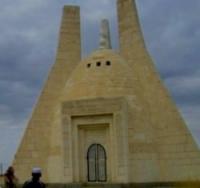You are here
Mausoleum of Kotybar batyr.

Monuments of the history of Aktobe region.
“...At the crossroads of the steppes I also met Isyr Kutibarov, the batyr, even before he led the anti-colonial movement in the Aral Sea region, among some Kazakhs of the Lesser Zhuz. Iset was built like Hercules; his athletic forms, his wild beauty and techniques, full of courage, could hit the European and had a strong influence in his circle”
Head of the Asian Department of the Ministry of Foreign Affairs of the Russian Empire E.P. Kovalevsky (1839 - 1840).
Mausoleums of Atyrau region.
Kazakh people have a special mentality formed in complicated historical conditions and expressing by honoring forefathers – talented statesmen, brave people's batyrs, and protectors of the native land. Yeset batyr mausoleum is a beautiful and refined monument at the grave of a great son of Kazakh people, people's protector Yeset Kokiuly batyr.
It is situated at Bestamak village, located approximately 44 km to south Aktuybinsk. Yeset batyr is a famous Kazakh batyr and commander, a tarkhan- a presentative of the highest military-tribal aristocracy (1667 - 1749).
He is from Tama tribe, Zhetiru clan of the Younger zhuz, was married the daughter of Bogenbay from the Younger zhuz, Tabyn clan who furthered joining of Kazakhs of the Younger and the Middle zhuzes to Russia. Theword"Yeset"is translated as"worthy"from Persian.
Yeset's father, Koki Bazarkululy was also a famous batyr, he was called "Taimas batyr" ("does not retreat"). Yeset started to take part in battles against Dzungars. He was called a batyr for his heroism. He was noticed by Tauke khan in one of the battles and young Yeset he got his blessing for his heroism and fearlessness.
In 1700 Yeset became the bi of department of clan, in 1710 he was a ruler of Tama clan, 1722 he became the Commander of Chief of the union of Zhetiru tribes. Yeset batyr headed troops of the Younger zhuz in victorious battles under Tauke khan.
Yeset batyr was friends with the khan of the Younger zhuz Abulhair and was the head of his troops several times. In 1720s he took the command of 20 thousand strong detachment of Abulhairand he repulsed attacks of Kalmyk and Bashkir raider in 1720 - 1745.
In 1726-1728 hewas as a hostage in the headquarters of the placeman of Kalmyk khanate Tseren-Donduk. In the spring of 1730 united forces of three zhuzes repulsed Dzungar invaders in Balhash battle, at Anyrakay and Yesetbatyr showed himself as an excellent tactician by heading the main forces of the Younger zhuz, he broke the enemy's defense and made them run away.
He furthered joining of Kazakhstan to Russia with Abulhairkhan.OnOctober 10, 1731 Yeset batyr under the command of Abulhairkhan and other leaders of the Younger zhuz he took his oath to be faithful to tsarist government.
Yeset batyr took the oath to be faithful to Russian government for the second time in, Orenburg, 1740 taking part in negotiations between feudal lords of the Middle and the Younger zhuzes and the chairman of Orenburg commission a duke V. Urusov.
ThenYeset batyr took an active part in development of economical and political relations between peoples, also in struggle against Ydil Kalmyk people who impeded the process of joining of Kazakhstan to Russia.
Yeset Kokiuly was not only a talented commander of his time but a politician and statesman, a true fighter for freedom and independence. Yeset batyr died at 82 in 1749. He was buried on the hill at Bestamak village, near the Ilek River, 35 km on the south-east Atktobe.
Yeset Kokiuly mausoleum was built here on the top of the hill in 1750. In 1979 local residents erected a gravestone made from the white brick in honor of the batyr contrary existed ideology of that time. The height of the gravestone is 1, 7 meters, the width is 3 meters, and length is 5 meters.
However there was an order to demolish this gravestone. The present mausoleum was built in 1992 for celebration his 325anniversary. The mausoleum was erected from pink coquina brought from Mangystau. The height of the mausoleum is 11 meters, the width is 5 meters.
Architectural look of the mausoleum resembling the yurt in order to it would be seen for a stranger passing these places. The author of the mausoleum is T. Dzhonysbekov. The monument had a cubic foundation and helmet-shaped cupola.There is a stylized image of the batyr his height on the west wall (the height of bust is 3 meters).
Epigraphic frieze was set on the upper edge of the carcass of the mausoleum.There is the first embankment over the grave in the centre of the chamber, surrounded with a box-sarcophagus from panels of coquina. Memorial stele and 2 panels with Arabic signs are situated at the east wall.
The mausoleum was registered as a historical monument was included to a tourist rout and is protected by the government. Asphalt road and bridge were laid across the Ilek River. The house for guests and pilgrims was built here. There are separate rooms for guests and for prayer and rest.
There is a place for sacrifice and cooking. All guests can visit it at any time. The mausoleum is a really sacred one and no one stranger dares to go pass this place without doing homage and admiration to this great ancestor. Many pilgrims came to pay honors to a famous hero of Kazakh people.
Authority:
http://culturemap.kz







